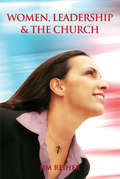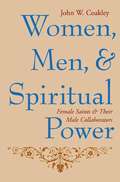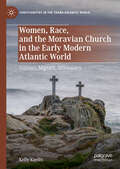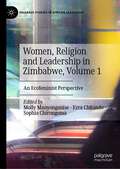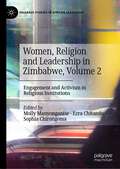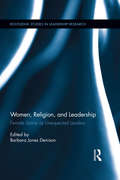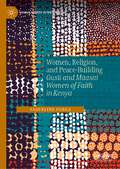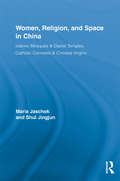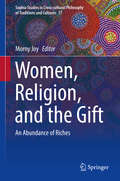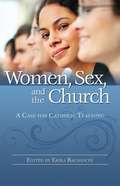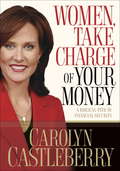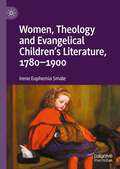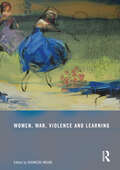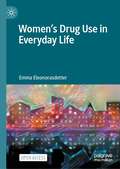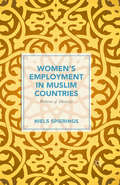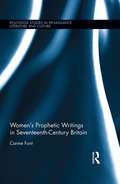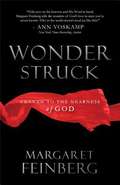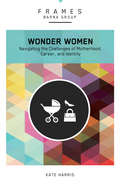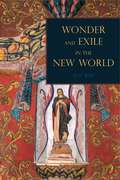- Table View
- List View
Women, Leadership and the Church
by Jim ReiherDoes God want women in the pulpit or the pews? Jim Reiher makes no secret of where he stands on one of the Church's most vexed issues. He uses the Bible to argue that women's gifts are to be affirmed. Timely and thought provoking, this book offers readers a fresh look at this controversial topic.
Women, Men, and Spiritual Power: Female Saints and Their Male Collaborators
by John CoakleyIn Women, Men, and Spiritual Power, John Coakley explores male-authored narratives of the lives of Catherine of Siena, Hildegard of Bingen, Angela of Foligno, and six other female prophets or mystics of the late Middle Ages. His readings reveal the complex personal and literary relationships between these women and the clerics who wrote about them. Coakley's work also undermines simplistic characterizations of male control over women, offering an important contribution to medieval religious history.Coakley shows that these male-female relationships were marked by a fundamental tension between power and fascination: the priests and monks were supposed to hold authority over the women entrusted to their care, but they often switched roles, as the men became captivated with the women's spiritual gifts. In narratives of such women, the male authors reflect directly on the relationship between the women's powers and their own. Coakley argues that they viewed these relationships as gendered partnerships that brought together female mystical power and male ecclesiastical authority without placing one above the other. Women, Men, and Spiritual Power chronicles a wide-ranging experiment in the balance of formal and informal powers, in which it was assumed to be thoroughly imaginable for both sorts of authority, in their distinctly gendered terms, to coexist and build on each other. The men's writings reflect an extended moment in western Christianity when clerics had enough confidence in their authority to actually question its limits. After about 1400, however, clerics underwent a crisis of confidence, and such a questioning of institutional power was no longer considered safe. Instead of seeing women as partners, their revelatory powers began to be viewed as evidence of witchcraft.
Women, Race, and the Moravian Church in the Early Modern Atlantic World: Convert, Migrant, Missionary (Christianities in the Trans-Atlantic World)
by Kelly KaelinThis book focuses on women’s participation in the Moravian Church during the eighteenth century, focusing on the intentional practice of international marriage and migration that supported their missionary work amongst enslaved populations in the Caribbean. It argues that white women missionaries and Black women converts played a crucial role in the history of its religious movement as the Church shifted from an ethnically German organization to a form of Black Atlantic Christianity.
Women, Religion and Leadership in Zimbabwe, Volume 1: An Ecofeminist Perspective (Palgrave Studies in African Leadership)
by Ezra Chitando Sophia Chirongoma Molly ManyonganiseZimbabwe has invested in women’s emancipation and leadership while articulating a strong Pan-Africanist ideology, providing a valuable entry point into understanding the dynamics relating to women’s leadership in Africa. It is also characterised by radical religious pluralism, thereby facilitating an appreciation of the impact of religion on women’s leadership in Africa more generally.This volume reflects on the role of Zimbabwean women in religio-cultural leadership. It opens with an expansive literature review on leadership, with a specific focus on African women’s leadership in the context of global studies on leadership. The chapters then discuss the unique Zimbabwean women’s leadership roles in ecological conservation. Topics include disaster management, the SDGs, and ecological stewardship.The book closes with examining women’s leadership among adherents of African Indigenous Spirituality, such as among the Shona and Ndau ethnic groups. It will appeal to scholars across management, women’s studies, religion, and cultural studies contemplating on African women’s leadership in religion as well as other areas of life.
Women, Religion and Leadership in Zimbabwe, Volume 2: Engagement and Activism in Religious Institutions (Palgrave Studies in African Leadership)
by Ezra Chitando Sophia Chirongoma Molly ManyonganiseZimbabwe has invested in women’s emancipation and leadership while articulating a strong Pan-Africanist ideology, providing a valuable entry point into understanding the dynamics relating to women’s leadership in Africa. It is also characterised by radical religious pluralism, thereby facilitating an appreciation of the impact of religion on women’s leadership in Africa more generally. This volume reflects on the role of Zimbabwean women in religio-cultural leadership, with a specific focus on roles within religious organizations. It begins by examining Zimbabwean church women’s leadership roles in long established faith communities. The chapters then hone in on the emergence of churches or ministries founded by women in Zimbabwe, starting from the pre-colonial era and advancing through the last forty years of independence. Hence, the book offers a comprehensive assessment of the challenges and opportunities women in leadership face in religious institutions in the country, before exploring the impact of the pandemic on the ability of women to lead. It will make a major contribution to the advancement of scholarship of gender and leadership in emerging markets.
Women, Religion and Leadership: Female Saints as Unexpected Leaders (Routledge Studies in Leadership Research)
by Barbara DenisonWomen, Religion and Leadership focuses on women from the traditional context of women as leaders with chapters observing various aspects of leadership from specifically chosen religious female leaders and going on to examine the legacies they leave behind. This book seeks to identify and analyse the gendered issues underlying the structural lack of recognition for women within the church and to examine the culturally constructed narratives related to these women for evidence of their leadership despite the exclusionary rules applied to force their submission to the dominating forces. Finally this book intends to draw out of these women’s stories the various lessons of leadership that invoke current relevancies among prevailing leadership paradigms. Written by experts from disciplines as varied as leadership and communication studies to sociology, and history to medievalist and English scholars; Women, Religion and Leadership will prove key reading for scholars, academics and researchers is these and related disciplines.
Women, Religion, and Peace-Building: Gusii and Maasai Women of Faith in Kenya (Human Rights Interventions)
by Jaqueline OgegaThis book explores the peacebuilding ideas and experiences of Maasai and Gusii women of faith in Kenya. Women of faith across the world have long demonstrated their leadership in peacebuilding. They have achieved this despite their underrepresentation in formal peacebuilding systems and the persistent lack of consideration for their critical contributions, and in the face of insecurity and violence against their very bodies. Their efforts include daily practices of sharing resources, building social cohesion, promoting human relations, and interlinking psychological, social, political, and spiritual encounters. This book provides a gender-responsive peacebuilding framework that leverages the intersectionality of women’s diverse identities and roles as they navigate both secular and religious spaces for peace. The book will appeal to researchers and teachers as well as practitioners and activists.
Women, Religion, and Space in China: Islamic Mosques & Daoist Temples, Catholic Convents & Chinese Virgins (Routledge International Studies of Women and Place)
by Maria Jaschok Jingjun ShuiWhat enables women to hold firm in their beliefs in the face of long years of hostile persecution by the Communist party/state? How do women withstand daily discrimination and prolonged hardship under a Communist regime which held rejection of religious beliefs and practices as a patriotic duty? Through the use of archival and ethnographic sources and of rich life testimonies, this book provides a rare glimpse into how women came to find solace and happiness in the flourishing, female-dominated traditions of local Islamic women’s mosques, Daoist nunneries and Catholic convents in China. These women passionately – often against unimaginable odds – defended sites of prayer, education and congregation as their spiritual home and their promise of heaven, but also as their rightful claim to equal entitlements with men.
Women, Religion, and the Gift
by Morny JoyThis book introduces the special dynamics of women and their close relationships with the gift in both past and contemporary religious settings. Written from a cross-cultural perspective, it challenges depictions of women's roles in religion where they have been relegated to compliance with specifically designated gendered attributes. The different chapters contest the resultant stereotypes that deny women agency. Each chapter describes women as engaged in an aspect of religion, from that of ritual specialists, to benefactors and patrons, or even innovators. The volume examines topics such as sainthood and sacrifice so as to refine these ideas in constructive ways that do not devalue women. It also examines the meaning of the term "gift" today, embracing the term in both figurative and literal ways. Such a collection of diverse women's writings and activities provides a significant contribution to their quest for recognition, and also suggests ways this can be understood and realized today.
Women, Ritual, and Power: Placing Female Imagery of God in Christian Worship
by Elizabeth UrsicMany Christians do not know the Bible contains female images of God because they have never heard nor seen them in church. In Women, Ritual, and Power, Elizabeth Ursic gives the reader insight into four Christian communities that worship God with female imagery, both as a worship focus and a community identity. These Methodist, Presbyterian, Lutheran, and Catholic congregations operate within their established church denominations and are led by either ordained Protestant ministers or vowed Catholic sisters. Because expressing God-as-She can expose strident claims for maintaining God-as-He, this book shows not only how patriarchy continues to operate in churches today, but also how it is being successfully challenged through liturgy.
Women, Sex, & the Church
by Erika BachiochiThe contributors to Women, Sex, and the Church challenge the common misconception that Catholic teachings are anti-women and anti-sex. Instead, these women explore how controversial teachings on abortion, sex, marriage, contraceptioon, and reproductive technologies evidence the Church's love of women.
Women, Take Charge of Your Money
by Carolyn CastleberryCreate, Consider, Invest It's a financial wake-up call. God is the One calling you--and He's calling collect. The good thing is, He provides the ideal model for you to follow on your way to reaping monetary rewards and gaining even more of your greatest asset on this earth: time. Carolyn Castleberry leads women through the process of creating, considering, and investing. Creating involves planning for your new life--you'll learn to take responsibility and identify a mission statement. Considering means you'll evaluate your investment options and trust the Holy Spirit. By the time you're ready to invest, you'll create a realistic budget, understand the credit game, and create an action plan for conquering debt. This book is your ticket to a new life grounded in financial freedom! A Proven Plan for Financial Success Meet your problem: Today's volatile job market is about to take you hostage (or already has). You suddenly have huge financial responsibilities you never had before. Retirement looms, begging you for a plan. Thinking about, dealing with, or strategizing anything "money" bores you, freaks you out, or makes you feel stupid. Meet your guide: "My own financial journey began the day I realized that I didn't know anything about money. Never mind that I had a business degree and hosted a national radio show for women. " --Carolyn Castleberry Meet your solution: Follow the game plan set by a biblical woman aptly called Proven, and you'll learn to o Create, o Consider, and o Invest. Discover the secret to making your money work for you. Become empowered to create a realistic budget, understand the credit game, design a debt-defeating action plan, and take charge of your money. Simple. Conversational. Even humorous. For every (smart) modern woman. "A must-read for anyone who desires to find significance in life." Kelly Wright National network correspondent "God has always had His love and favor on women, and when we understand our role from God's perspective, we become liberated to fulfill our purpose." Anne Beiler Founder of Auntie Anne's, Inc. "God never said for you to be either passive or in the dark about money. Read this and get busy. You will be glad you did." Dr. Henry Cloud Bestselling author of the Gold Medallion Award-winning Boundaries Story Behind the Book"The day I realized I didn't know anything about money--even though I have a business degree and experience hosting a national business radio show for women--was the day I held my baby girl in my arms for the first time. I did not have a choice about whether to work or stay at home; we simply didn't have enough money. After applying this financial model, I was able to walk away from a job in television news that I had held for fourteen years. God means it when He offers us abundant life, here and eternally. This book reveals a realistic example for today's women who long to be free and have meaningful, prosperous lives." --Carolyn CastleberryFrom the Trade Paperback edition.
Women, Theology and Evangelical Children’s Literature, 1780-1900
by Irene Euphemia SmaleThis book provides a wealth of fascinating information about many significant and lesser-known nineteenth-century Christian authors, mostly women, who were motivated to write material specifically for children’s spiritual edification because of their personal faith. It explores three prevalent theological and controversial doctrines of the period, namely Soteriology, Biblical Authority and Eschatology, in relation to children’s specifically engendered Christian literature. It traces the ecclesiastical networks and affiliations across the theological spectrum of Evangelical authors, publishers, theologians, clergy and scholars of the period. An unprecedented deluge of Evangelical literature was produced for millions of Sunday School children in the nineteenth century, resulting in one of its most prolific and profitable forms of publishing. It expanded into a vast industry whose magnitude, scope and scale is discussed throughout this book. Rather than dismissing Evangelical children’s literature as simplistic, formulaic, moral didacticism, this book argues that, in attempting to convert the mass reading public, nineteenth-century authors and publishers developed a complex, highly competitive genre of children’s literature to promote their particular theologies, faith and churchmanships, and to ultimately save the nation.
Women, War, Violence and Learning
by Shahrzad MojabThis anthology provides fresh theorization of gendered dimensions of learning, war, and violence, with a view to offering new insights on the impact of violence on women’s learning and well being. The collection is an important contribution to emerging interdisciplinary approaches to the role and effectiveness of civil society, especially women’s NGOs, working in war and post-conflict zones, and to the relationship between neoliberal, global ‘feminist’ projects and the re-emergence of colonial and imperial feminisms. This collection is also an exploration of the plausibility of current peace education strategies augmenting the political and leadership role of women and their civic engagement.This collection is designed to create a space for conversation across disciplines on such issues as how to advance our conceptualization of gender-related education and conflict; how to provide empirically-based case studies and transnational analyses that improves our understanding of the impact of war and violence on women’s learning; and how to contribute to national and international policy analyses to improve education for women and girls, through related policy reforms or humanitarian aid programs in post-war reconstruction efforts.This book was published as a special issue in the International Journal of Lifelong Education.
Women, Work, and Worship in Lincoln's Country: The Dumville Family Letters
by Anne Heinz John HeinzThe Dumville family settled in central Illinois during an era of division and dramatic change. Arguments over slavery raged. Railroads and circuit-riding preachers brought the wider world to the prairie. Irish and German immigrants flooded towns and churches. Anne M. Heinz and John P. Heinz draw from an extraordinary archive at the Abraham Lincoln Presidential Library and Museum to reveal how Ann Dumville and her daughters Jemima, Hephzibah, and Elizabeth lived these times. The letters tell the story of Ann, expelled from her Methodist church for her unshakable abolitionist beliefs; the serious and religious Jemima, a schoolteacher who started each school day with prayer; Elizabeth, enduring hard work as a farmer's wife, far away from the others; and Hephzibah, observing human folly and her own marriage prospects with the same wicked wit. Though separated by circumstances, the Dumvilles deeply engaged one another with their differing views on Methodism, politics, education, technological innovation, and relationships with employers. At the same time, the letters offer a rarely seen look at antebellum working women confronting privation, scarce opportunities, and the horrors of civil war with unwavering courage and faith.
Women’s Authority and Leadership in a Hindu Goddess Tradition
by Nanette R. SpinaThis book investigates women's ritual authority and the common boundaries between religion and notions of gender, ethnicity, and identity. Nanette R. Spina situates her study within the transnational Melmaruvathur Adhiparasakthi movement established by the Tamil Indian guru, Bangaru Adigalar. One of the most prominent, defining elements of this tradition is that women are privileged with positions of leadership and ritual authority. This represents an extraordinary shift from orthodox tradition in which religious authority has been the exclusive domain of male Brahmin priests. Presenting historical and contemporary perspectives on the transnational Adhiparasakthi organization, Spina analyzes women's roles and means of expression within the tradition. The book takes a close look at the Adhiparasakthi society in Toronto, Canada (a Hindu community in both its transnational and diasporic dimensions), and how this Canadian temple has both shaped and demonstrated their own diasporic Hindu identity. The Toronto Adhiparasakthi society illustrates how Goddess theology, women's ritual authority, and "inclusivity" ethics have dynamically shaped the identity of this prominent movement overseas. Based on years of ethnographic fieldwork, the volume draws the reader into the rich textures of culture, community, and ritual life with the Goddess.
Women’s Drug Use in Everyday Life
by Emma EleonorasdotterThis open access book explores the increasing role of psychoactive substances in contemporary everyday life, focussing on women's use. Drawing on an ethnographic study in Sweden, it uses cultural studies and queer phenomenology to analyse the women’s narratives of drug use relating to themes that encompass social, legal, cultural, embodied and gendered perspectives on drugs in the contemporary Western world. It examines topics such as stigma, happiness, children, the body, gifts, the drug market, medication, sickness and health and also the orientation of themselves towards others, to social and cultural norms, to drug laws and to the substances. It discusses how drug related spaces and directions be analysed in terms of gender and class, and how, in turn, the directions of contemporary society and culture can be affected by drug use. It speaks to academics in Sociology, Criminology, Ethnology, Gender studies, Law and History.
Women’s Employment in Muslim Countries: Patterns of Diversity
by Niels SpieringsThis book presents a new and nuanced exploration of the position of women in Muslim countries, based on research involving more than 300,000 women in 28 Muslim countries. It addresses topical debates on the role of Islam, modernization, globalization, neocolonialism, educational inequalities, patriarchy, household hierarchies, and more.
Women’s Prophetic Writings in Seventeenth-Century Britain (Routledge Studies in Renaissance Literature and Culture)
by Carme FontThis study examines women’s prophetic writings in seventeenth-century Britain as the literary outcome of a discourse of social transformation that integrates religious conscience, political participation, and gender identity. The following pages approach prophecy as a culture, a language, and a catalyst for collective change as the individual prophet conceptualized it. While the corpus of prophetic writing continues to grow as the result of archival research, this monograph complements our particular knowledge of women’s prophecy in the seventeenth century with a global assessment of what makes speech prophetic in the first place, and what are the differences and similarities between texts that fall into the prophetic mode. These disparities and commonalities stand out in the radical language of prophecy as well as in the way it creates an authorial centre. Examining how authorship is represented in several configurations of prophetic delivery, such as essays on prophecy, poetic prophecy, spiritual autobiography, and election narratives, the different chapters consider why prophecy peaked in the years of the civil wars and how it evolved towards the eighteenth century. The analyses extrapolate the peculiarities of each case study as being representative of a form of textually-based activism that enabled women to gain a deeper understanding of themselves as creators of independent meaning that empowered them as individuals, citizens, and believers.
Wonder
by Robert C. FullerThe attempt to identify the emotional sources of religion goes back to antiquity. In an exploration that bridges science and spirituality, Robert C. Fuller makes the convincing case that a sense of wonder is a principal source of humanity's belief in the existence of an unseen order of life. Like no other emotion, Fuller argues, wonder prompts us to pause, admire, and open our hearts and minds.With a voice that seamlessly blends the scientific and the contemplative, Fuller defines wonder in keeping with the tradition of Socrates--as an emotion related to curiosity and awe that stimulates engagement with the immediate physical world. He draws on the natural and social sciences to explain how wonder can, at the same time, elicit belief in the existence of a more-than-physical reality. Chapters examining emotions in evolutionary biology and the importance of wonder in human cognitive development alternate with chapters on John Muir, William James, and Rachel Carson, whom Fuller identifies as "exemplars of wonder." The writings and lives of these individuals express a functional side of emotion: that the very survival of life on earth today may depend on the empathy, compassion, and care that are aroused by a sense of wonder.Forging new pathways between the social sciences, philosophy, belief, and cultural history, Wonder deepens our understanding of the complex sources of personal spirituality and fulfillment.Bridging science and spirituality, Robert Fuller makes the convincing case that a sense of wonder is a principal source of humanity's belief in the existence of an unseen order of life. Like no other emotion, he argues, wonder prompts us to pause, admire, and open our hearts and minds. Chapters examining emotions in evolutionary biology and the importance of wonder in human cognitive development alternate with chapters on John Muir, William James, and Rachel Carson, whom Fuller identifies as "exemplars of wonder." The writings and lives of these individuals express a functional side of emotion: that the very survival of life on earth today may depend on the empathy, compassion, and care that are aroused by a sense of wonder.-->
Wonder Struck: Awaken To The Nearness Of God
by Margaret FeinbergLet's be honest: it's far too easy to go through day-to-day life without a sense of the mystery, the marvel, or the awe of God's presence. Have you ever felt your relationship with God isn't as vibrant as you want it to be? Have you ever felt like God seemed far away--even in the midst of devotions, prayer, and church? You're not alone. We Were Created for wonder. You were created and designed to experience wonder. Woven into the fabric of our humanity is an innate ability and desire for the wonder of God. It's felt in the moments when you watch the sun melt behind the horizon, when you reach out to cradle a baby and smell the sweet scent of new life, when you can't help but smile as you witness two wrinkled souls renew their vows to each other. Such moments remind us we were made for something more than deadlines and debt, carpools and coffee breaks. Yet despite such wondrous moments, we can still find ourselves going through the motions of faith. Whether you're a long time follower of Jesus or still figuring Him out, unemployed, overly-employed, or an entrepreneur a creator, innovator, or conformist, grumpy, ebullient, grey-haired or bed-head, an average Joe or have-a-gym-membership-but-never-go, a superhero (of any era), supermom, superdad, super grand, super great grand, or don't feel particularly super at all-- No matter who you are or where you've been--if you've lived a life where you've seen it all, done it all, or feel like you're past it all--God still longs to take your breath away. Isaiah 29:4 records God's desire for you: "Therefore once more I will astound these people with wonder upon wonder. " Do you see it? God is busting at the seams to display His glory, power, and might in your life. And He wants to give you the greatest gift of all--Himself. Yet why do we pass by the wonder of God unaware?
Wonder Women: Navigating the Challenges of Motherhood, Career, and Identity
by Barna Group Kate HarrisThere is a new reality for mothers in the 21st century-it's a different world with different goals than it was even a generation ago. As little girls, today's moms didn't grow up with ONLY dolls and toy kitchens and princesses and visions of idyllic domesticity and motherhood behind a white picket fence: they were given these but also a little plastic doctor's bag and a coloring book full of potential careers to choose from. "You can be anything you want, child." It's a message of empowerment and it's beautiful. But, as many of those young girls grew up, a message that was once meant to convey opportunity has begun to feel like a pressure cooker. What once was "You can have it all" has now become "You need to have it all." You need to have the perfect job, the perfect husband, the perfect house, the perfect kids, the perfect play dates and craft nights and date nights and DIY Pinterest projects and #nofilter Instagrams. What does it mean to be a mom in a world like that? Where does vocation fit into all this? What does a holistic idea of self fit in? Many women struggle with the decision to work inside the home or outside the home. How can you maintain a sense of self and motherhood in both decisions? The reality is we can't really have it all - sometimes we will have to make choices. This Barna Frame explores the value and beauty in those constraints. Join Kate Harris, wife, mother, and the executive director of The Washington Institute for Faith, Vocation, and Culture, as she unpacks the identity questions, the economic realities, and the role of the church in your life as you feel compelled to be wonder woman.
Wonder and Exile in the New World
by Alex NavaIn Wonder and Exile in the New World, Alex Nava explores the border regions between wonder and exile, particularly in relation to the New World. It traces the preoccupation with the concept of wonder in the history of the Americas, beginning with the first European encounters, goes on to investigate later representations in the Baroque age, and ultimately enters the twentieth century with the emergence of so-called magical realism. In telling the story of wonder in the New World, Nava gives special attention to the part it played in the history of violence and exile, either as a force that supported and reinforced the Conquest or as a voice of resistance and decolonization. Focusing on the work of New World explorers, writers, and poets—and their literary descendants—Nava finds that wonder and exile have been two of the most significant metaphors within Latin American cultural, literary, and religious representations. Beginning with the period of the Conquest, especially with Cabeza de Vaca and Las Casas, continuing through the Baroque with Cervantes and Sor Juana Inés de la Cruz, and moving into the twentieth century with Alejo Carpentier and Miguel Ángel Asturias, Nava produces a historical study of Latin American narrative in which religious and theological perspectives figure prominently.
Wonder and Exile in the New World
by Alex NavaIn Wonder and Exile in the New World, Alex Nava explores the border regions between wonder and exile, particularly in relation to the New World. It traces the preoccupation with the concept of wonder in the history of the Americas, beginning with the first European encounters, goes on to investigate later representations in the Baroque age, and ultimately enters the twentieth century with the emergence of so-called magical realism. In telling the story of wonder in the New World, Nava gives special attention to the part it played in the history of violence and exile, either as a force that supported and reinforced the Conquest or as a voice of resistance and decolonization. Focusing on the work of New World explorers, writers, and poets—and their literary descendants—Nava finds that wonder and exile have been two of the most significant metaphors within Latin American cultural, literary, and religious representations. Beginning with the period of the Conquest, especially with Cabeza de Vaca and Las Casas, continuing through the Baroque with Cervantes and Sor Juana Inés de la Cruz, and moving into the twentieth century with Alejo Carpentier and Miguel Ángel Asturias, Nava produces a historical study of Latin American narrative in which religious and theological perspectives figure prominently.
Wonder of Christmas
by Peg AugustineA look at the Christmas story with the emphasis on the “wonder” of the season. Each page begins with “I wonder…” and journeys chronologically from Mary and Joseph’s trip to Bethlehem through the Wise Men’s return home. A short prayer and biblical text follow this on each page. Each facing page has the Spanish translation of the story.
